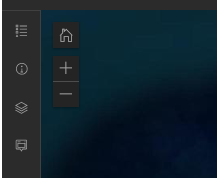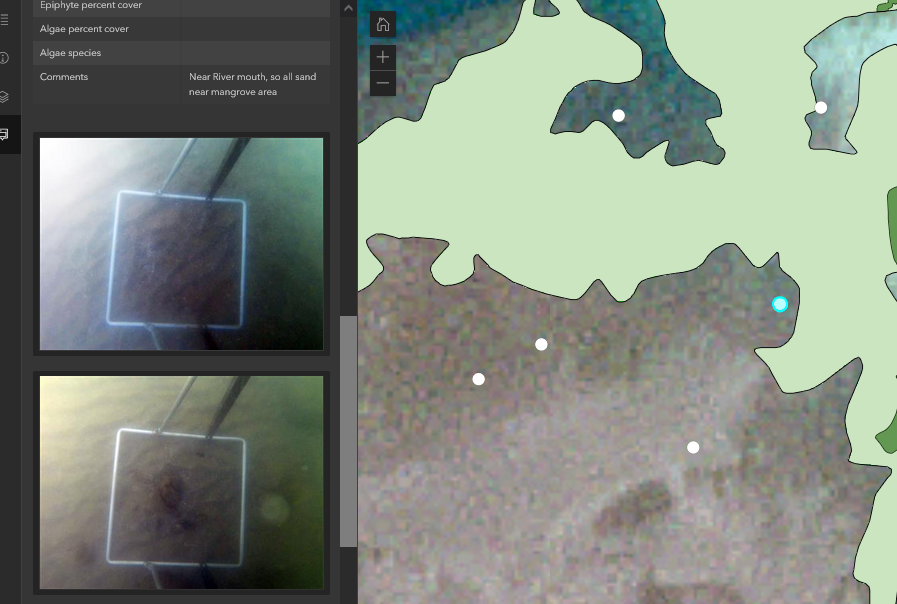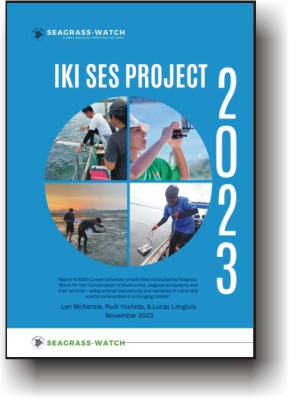PHILIPPINES
IKI Seagrass Ecosystem Services Project
Mapping Results
some cool facts
Some field facts
Some
field facts

How to use map viewer
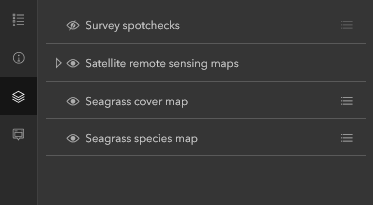 In Map Viewer, on the Contents (dark) toolbar (found on the left), select
In Map Viewer, on the Contents (dark) toolbar (found on the left), select ![]() (Layers) to display all the different map Layers.
(Layers) to display all the different map Layers.
The legend ![]() displays information about each layer that is visible at the current map scale. Not all layers contain legend information.
displays information about each layer that is visible at the current map scale. Not all layers contain legend information.
On the Contents (dark) toolbar, click (Legend). The legend displays information about each layer that is visible at the current map scale. Not all layers contain legend information.
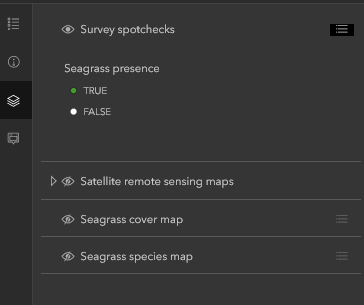 You do not need to show all map layers in the legend. For example, if the map focuses on seagrass distribution and extent for a region/country, you may want the legend to show only spotcheck symbols and not seagrass species and other reference data included in the map.
You do not need to show all map layers in the legend. For example, if the map focuses on seagrass distribution and extent for a region/country, you may want the legend to show only spotcheck symbols and not seagrass species and other reference data included in the map.
To hide a layer in the legend, do the following:
- Open the map with the legend in which you want to hide a layer.
- On the Contents (dark) toolbar, click Layers
 .
. - Browse to the layer you want to hide (turn off) or show (turn on).
- The layer visibility can then be turned on (Show layer
 ) or off (Hide layer
) or off (Hide layer  ) by clicking the eye symbol on the list.
) by clicking the eye symbol on the list.
Using the mouse wheel makes it easy to zoom and pan anytime you like without changing the tool you are currently using.
These shortcuts work in data view and layout view. In layout view, they apply to the page by default. You can hold down the SHIFT key and perform any shortcut to apply it to the data frame instead of the page (the active data frame in the case of rolling the mouse wheel, or the data frame you clicked in the case of clicking or dragging the mouse wheel).
| Mouse wheel action | ArcMap navigation function |
|---|---|
| Rolling wheel back and forth | Zooms in and out |
| Holding down CTRL and rolling | Zooms in and out but with finer increment; used for small adjustments |
| Clicking mouse wheel (or middle mouse button) | Centers map at location where you clicked |
| Holding down mouse wheel (or middle mouse button) and dragging | Pans |
| Holding down CTRL and clicking mouse wheel | Centers and zooms in at location you clicked |
| Holding down CTRL and dragging with the mouse wheel | Zooms in |
ulugan bay seagrass mapping results
Philippines

Partner: ZSL
Field Mapping: completed
Data Management: completed
QAQC/analysis: completed
Map Creation/Reporting: completed
Seagrass meadows within Ulugan Bay, Palawan, Philippines, were assessed between the 30 October 2020 and 09 May 2023.
Observers walked or used drop-cameras to collect photoquadrats at mapping points, which were positioned using a restricted random sampling design. Visual estimates of above-ground seagrass percent cover, seagrass species and macroalgae percent cover were recorded at each mapping point from 3 quadrats (50cm x50cm), using globally standardised Seagrass-Watch protocols. Substrate type was assessed at each mapping point by hand, and aided by a Van Veen grab at subtidal points. A differential handheld global positioning system (GPS) was used to locate each mapping point (accuracy ±3m).
A total of 692 individual points were examined, of which 445 were collected from drop-camera, 180 in-situ and 69 from Seagrass .
Seagrass was present at 309 of the mapping points, with percentage cover ranging from 0.1 to 100%, and with an average of 20.8%. Eight seagrass species were identified, with the most frequently encountered being Enhalus acoroides, Halophila ovalis and Thalassia hemprichii (36.2%, 15.4% and 10.9% average cover, respectively).
Spatially explicit seagrass maps were created from PlanetScope Dove (3.7 m × 3.7 m pixel) imagery, using the field validation point data and a machine-learning model (random forest). A total of 86.8 to 323 hectares, with an additional 10.2 ha (manually digitized from subtidal and/or turbid area where imagery does not allow for reliable predictions) of seagrass meadows were mapped within Ulugan Bay.
The southern coastal area,around Macarascas, was mainly dominated by Enhalus acoroides (inshore) with some smaller sections of Thalassia hemprichii, Halophila ovalis and Syringodium isoetifolium near the reef crest.
North along the East coast of Ulugan Bay, seagrass meadows changes from Enhalus acoroides dominated meadows to Thalassia hemprichii. There is a change back to Enhalus acoroides dominated meadows with a greater diversity around Buenavista where there are smaller patches of varying seagrass communities some dominated by Halodule uninervis and Cymodocea rotundata.
The west side of Ulugan Bay, there is a decrease in seagrass, which mostly Halophila ovalis and Thalassia hemprichii dominated meadows except for Rita Island which comprised of some Halodule uninervis dominated meadows.
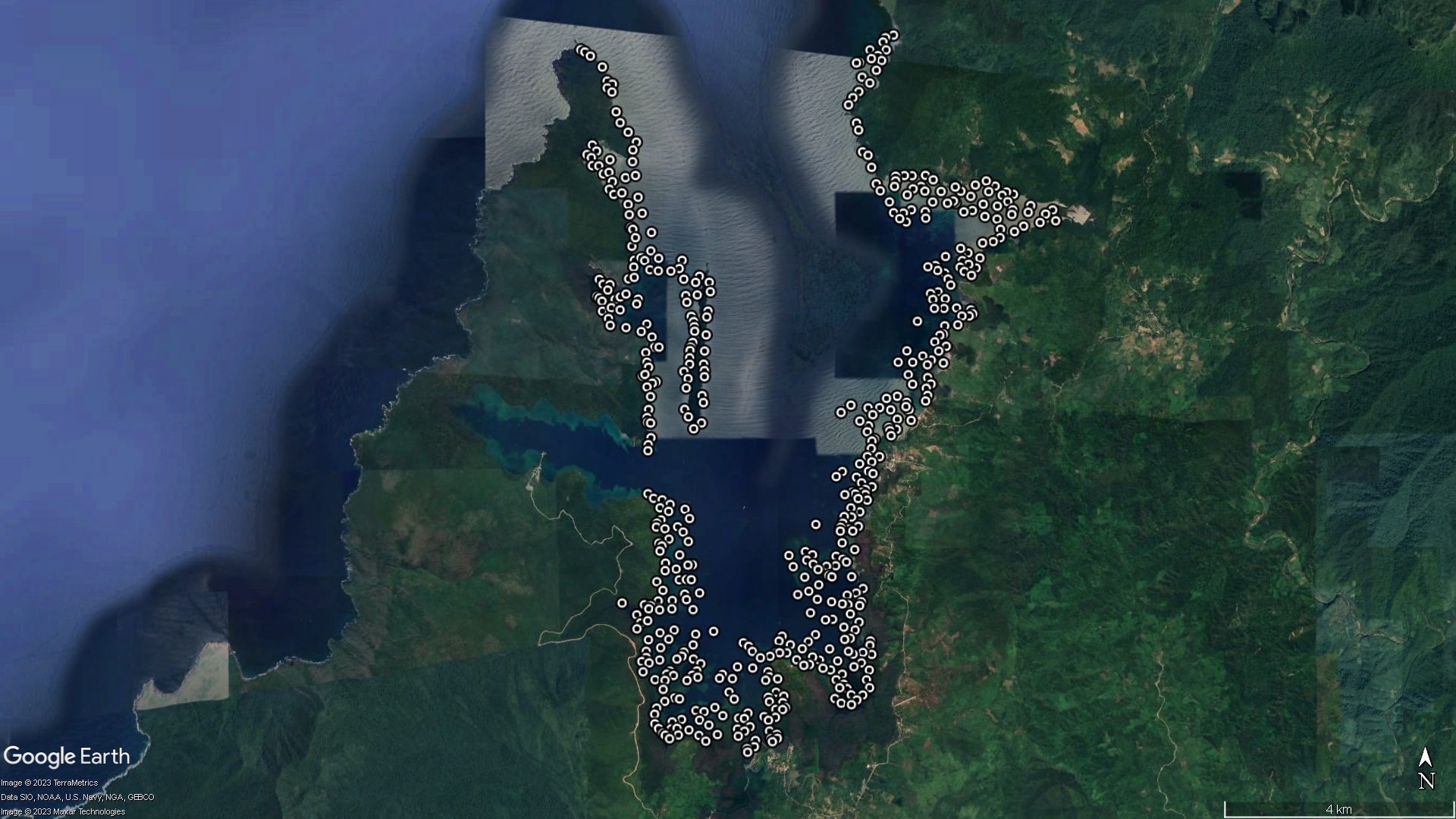
How the data was collected
Field validation points were spatially balanced and randomised within the Area of Interest (AOI). All data collected within the AOI was used to ensure mapping of all seagrass meadows present.
At each field validation point, teams conducted a spot-check using either Drop-Cam, in situ observation, or grab.
Photoquadrats were captured (except where only a grab sampler was used) during each spot-check. Photoquadrats were either geotagged or geolocated. Data collected from the photoquadrats (e.g. % cover and species) at each point and the Seagrass Spotter sightings were used to train and validate models for classification of satellite imagery.
philippines seagrass
Partnership

Working with ZSL , Seagrass-Watch (in partnership with IKI) aimed to collate rich but dispersed seagrass distribution information into an easily searchable, viewable and fully customisable map-based view for seagrass meadows of Ulugan Bay
This project is part of the International Climate Initiative (IKI). The Federal Ministry for the Environment, Nature Conservation and Nuclear Safety (BMU) supports this initiative on the basis of a decision adopted by the German Bundestag.

